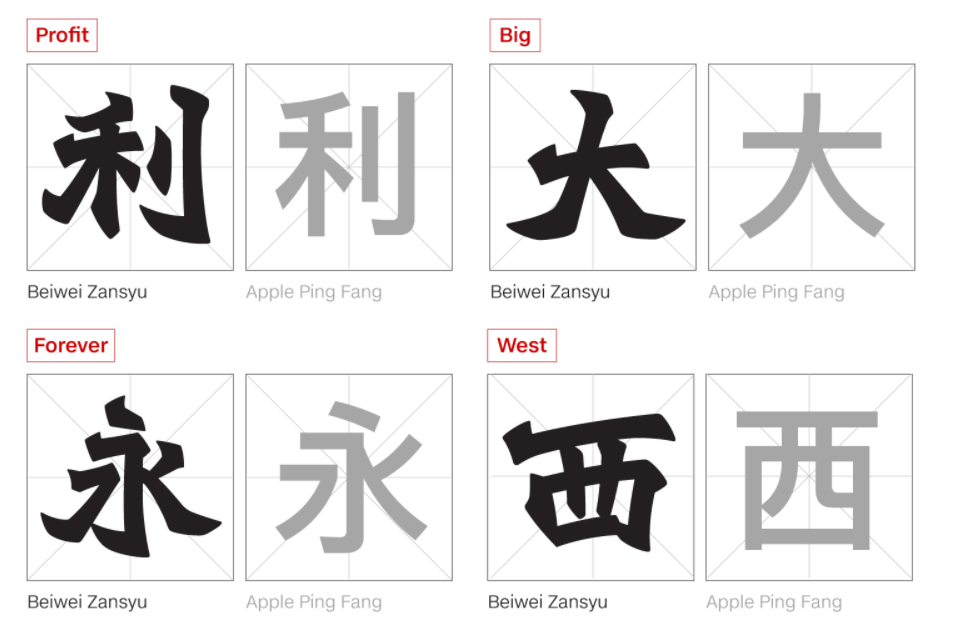古代书法的数字化艺术
古代书法的数字化艺术
From the moment we wake up and check the messages on our smartphones, we're exposed to text design. Throughout our day, storefronts and websites announce themselves, first and foremost, through the typefaces they use.
从我们醒来查看智能手机上的信息的那一刻起,我们就接触到了文本设计。在我们的日常生活中,商店和网站首先通过他们使用的字体来展示自己。
For Adonian Chan, a 33-year-old graphic designer based in Hong Kong and co-founder of design company Trilingua, the different texts we encounter in our daily lives amount to what he calls a "visual landscape."
对于一位33岁的香港平面设计师兼设计公司Trimuja的联合创始人艾杜年·陈来说,我们日常生活中遇到的不同文本相当于他所说的“视觉景观”。

In his hometown, signs written in traditional Chinese characters can be found around every corner. In the hectic district of Mong Kok, neon signs advertise pay-by-the-hour hotels and foot massage parlors.
在他的家乡,用繁体字写的招牌随处可见。在繁忙的旺角,霓虹灯招牌上写着按小时收费的酒店和足底按摩店。
According to Keith Tam, head of communication design at the Hong Kong Design Institute, Beiwei Kaishu originated in the Northern Wei Dynasty (386 -- 534 AD), and was inscribed on stones to document historical events.
据香港设计研究院传播设计主管基思·谭介绍,北魏楷书起源于北魏(公元386-534年),被刻在石头上以记录历史事件。
Tam says although it's not possible to pinpoint when Beiwei Kaishu made its way to Hong Kong, a well-known local calligrapher named Au Kin Kung, who was born in the 1880s, helped to spread its popularity in the city during the 20th century.
谭说,虽然无法确定北魏楷书是什么时候来到香港的,但20世纪时,一位出生在19世纪80年代的香港著名书法家区建公帮助它在香港普及。
"[Au] was what we might call a 'commercial calligrapher,' who inscribed many shops and organizations throughout Hong Kong," says Tam. "His commercial signage work almost always used Beiwei Kaishu."
“区先生是我们可以称之为‘商业书法家’的人,他为香港各地的许多商店和组织题字,”谭说。“他的商业标识作品几乎都是使用北魏楷书。”
After World War II, Beiwei Kaishu was used prolifically in Hong Kong signage, partly because it is highly legible, even from far distances, says Tam. "Pragmatism is one of the characterizations of southern Chinese people, and Beiwei Kaishu seems to be a pragmatic choice."
谭说,二战后,北魏楷书在香港的标识中大量使用,部分原因是即使从很远的地方看也很清楚。“实用主义是中国南方人的特征之一,北魏楷书似乎就是一个实用主义的选择。”
What sets Beiwei Kaishu apart from other Chinese writing styles is its asymmetric construction, bold lines and unexpected angles -- something that makes it "energetic," says Chan.
《北魏楷书》的不对称结构、粗线条和意想不到的角度,是它与其他中国文字风格不同的地方——这使它“充满活力”,陈说。
But with the advent of computer-generated fonts, Chan says he observed that signs written in the style -- work that depended on the skill of calligraphers -- were disappearing from Hong Kong.
但随着电脑生成字体的出现,陈说,他注意到这种依靠书法家技巧而书写的标识正在从香港消失。
"It's almost extinct," says Chan, pointing to the rapid transformation of Hong Kong's urban landscape. "They demolish old buildings and, of course, the shops, as well. So it's really destruction to the visual culture." As a consequence, few designers working today are aware of the Beiwei Kaishu style, he says.
“它几乎灭绝了,”陈说,他指的是香港城市景观的快速变化。“他们拆除旧建筑,当然,还有商店。所以这真的是对视觉文化的破坏。”因此,他说,如今的设计师中很少有人知道北魏楷书的风格。

In 2016, Chan asked a master of calligraphy in Hong Kong and apprentice of the famed Au Kin Kung, to teach him to write in the Beiwei Kaishu style.
2016年,陈请香港的一位书法大师、著名的区建公的徒弟教他写北魏楷书。
Chan then started the process of digitizing the characters. He first writes the characters on paper with a brush and ink, which gives him a sense of proportion. Next, he makes a pencil sketch. Finally, he recreates the characters digitally, using a computer program called Glyphs.
然后,陈开始将这些汉字数字化。他首先用毛笔和墨水把字写在纸上,这给了他一种比例感。接下来,他用铅笔画了个草图。最后,他用一个名为Glyphs的计算机程序用数字技术重新创造了这些字符。
One of the main challenges when digitizing the ancient calligraphy is striking a balance between the artistic expression of handwritten lettering and the need for consistency and coherence in font design, says Chan.
陈说,将古代书法数字化的主要挑战之一是如何在手写字体的艺术表现和字体设计的一致性和连贯性之间取得平衡。
He can complete two characters a day, depending on their complexity, and is aiming to digitize 6,000 characters.
根据复杂程度的不同,他每天可以完成两个汉字,他的目标是把6000个汉字数字化。

Chan says his project is geared at doing more than preserving a centuries-old writing style and that he sees himself as building on the work of previous generations.
陈说,他的项目不仅仅是为了保存一种古老的写作风格,他认为自己是在前人的基础上发展起来的。
He hopes it will eventually be installed on phones and computers.
他希望它最终能安装在手机和电脑上。
- 频道推荐
- |
- 全站推荐
- 推荐下载
- 网站推荐


















